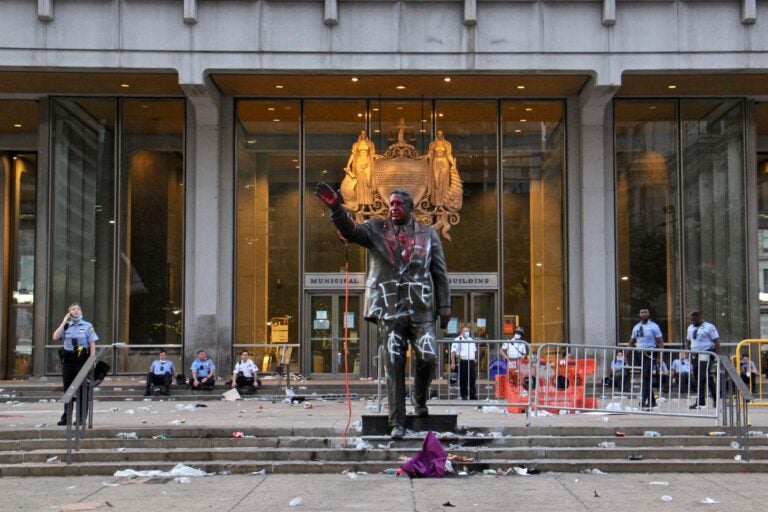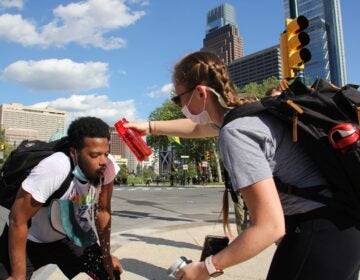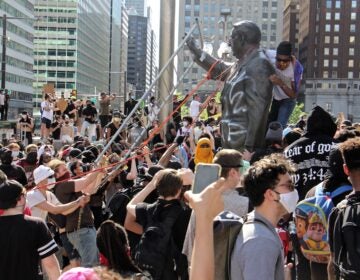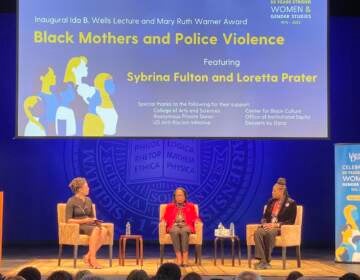‘Resources better spent rebuilding’: Philly Councilmembers call on mayor to stop spending city money to protect Rizzo statue
Mayor Kenney’s choice to spend city money protecting a statue honoring an opponent of desegregation known for brutal policing disturbs some at City Hall.

Philadelphia police officers guard the statue of Frank Rizzo after protests on May 30. (Emma Lee/WHYY)
Mayor Jim Kenney’s administration can’t say exactly how much taxpayer money has been spent to clean and guard a statue of former Mayor Frank Rizzo after it became a focal point during protests of police brutality and the asphyxiation death of George Floyd at the hands of law enforcement. But an accounting of past costs related to protecting the monument shows that the expenses add up and could be significant at a time when the city is facing an unprecedented budget crisis.
In 2017, the overtime costs to put 10 officers on the statue for a single day amounted to $3,851. Philadelphia Police Department sources have estimated the average overtime rate for a patrolman was about $50 an hour.
Now joined by National Guardsmen, a phalanx of police officers have stood watch over the statue of the avowed opponent of desegregation since Saturday afternoon. Early Sunday, as Center City merchants and volunteers took brooms to battered public streets, a city cleaning crew power-washed the Rizzo likeness.
The full police overtime costs related to protecting and cleaning the 10-foot-tall bronze icon won’t be known for another few weeks, according to Mike Dunn, a spokesman for the mayor. Nor would the costs of an initiative called the Community Life Improvement Project, which washed the statue after Managing Director Brian Abernathy’s office ordered the removal of “graffiti from all public and private locations in Center City,” Dunn said.
Police Commissioner Danielle Outlaw countered that the large number of armed officers around the monument were not there to specifically guard the statue of a man that many associate with police brutality. The cast figure of Rizzo stands immediately in front of the city’s Municipal Services Building and across from City Hall.
“We’re not protecting a statue, we’re protecting the core of the city,” Outlaw said at a Monday press briefing. “Optically it looks like we’re protecting a statue, but we’re protecting the facility.”
But the city’s actions shocked some councilmembers who have spent the last few weeks deep in debate over how best to spend limited public dollars in the midst of a pandemic and economic crisis.
“The Rizzo statue is a symbol of police brutality and systemic racism in Philadelphia. We should stop cleaning it, stop guarding it, stop planning to relocate it, and remove it from public view,” City Councilmember Kendra Brooks said. “Those resources could be better spent rebuilding the damage that was done over the past few days.”
A candidate who urged ‘vote white’ becomes a symbol of power
Kenney first promised to move the polarizing monument in 2017, after similar protests unfolded in the wake of the death of Heather Heyer, a counterprotester killed by a neo-Nazi in Charlottesville, Va., during the 2017 Unite the Right rallies. The statue became a similar locus for sympathetic protests and vandalism at the hands of demonstrators.
Afterward, the city similarly cleaned and guarded the statue –– at great expense –– but Kenney pledged to begin the process of relocating Rizzo’s likeness away from a public setting.
The statue was initially going to be removed as part of the larger renovation of Thomas Paine Plaza, Dunn said. But Kenney indicated on Sunday that he intends to have the statue relocated within a month.
Even removal would cost the city a pretty penny. Dunn said it would cost “$100,000 at minimum” –– although past estimates have put the bill closer to $200,000 –– linking both the cost and delays in relocating the 2,000-pound representation of the former mayor to engineering obstacles.
“The statue is bolted into the infrastructure of the plaza, which is also the roof of the underground concourse,” Dunn said Monday. “Removing it while ensuring the integrity of that infrastructure will be a complicated task.”
Rizzo rose from a patrol officer to head of the Philly PD and later served as mayor from 1972 to 1980. An opponent of equality for Black people who urged political supporters to “vote white,” Rizzo was elected on a wave of law-and-order politics that followed a decade of increasing civil rights protests and racial tension in Philadelphia’s rowhouse neighborhoods.

Subscribe to PlanPhilly
Some white communities have lionized his leadership while others, often people of color or political opponents, associate his administration with unrestrained police brutality.
The statue, which was cast by sculptor Zenos Frudakis, was donated to the city by Rizzo’s relatives some eight years after the former mayor’s death, in 1991. Rizzo’s family members have defended the statue, one of few cast depictions of former mayors, in the wake of repeated vandalism.
A peaceful protest at the Philadelphia Art Museum Saturday afternoon later moved to the statue of the police chief-turned-mayor adjacent to City Hall. As the mood of the protest turned, some unsuccessfully attempted to burn or pull down the effigy of Rizzo.
Rizzo’s grandson, Joe Mastronardo, told the Philadelphia Inquirer on Sunday that the calls for removal were a “typical liberal symbolic gesture that does absolutely nothing.”
“A lot of people’s opinions are second- and third hand, and now that race is such a huge topic again, they’ll just latch on to anything,” he said. “They want to make my grandfather a racist because he was a tough cop in a tough time.”
But to Councilmember Helen Gym, the city’s years-long failure to remove the statue from a public plaza had itself become symbolic.
“It’s a symbol of institutionalized power, the idea that things aren’t changing around policing and the city’s refusal to confront these problems,” she said. “It should have been moved three years ago.”
WHYY is your source for fact-based, in-depth journalism and information. As a nonprofit organization, we rely on financial support from readers like you. Please give today.








